Tugboats are usually seen,
and imagined, in the harbors and smaller waters of the world, docking an
undocking ships. These are the harbor boats and their job goes
basically like this.
The tug's captain moves the tug alongside the ship. The tug's crew
sends up a large line that the ship's crew makes fast to the ship.
Then the tug's crew fastens that line to the tug. once everything
is in place, the docking pilot, who is aboard the ship directing the
operation, calls out orders over the radio and the tug maneuvers as
necessary to help the ship into or out of her berth.
The equipment on deck is fairly easy to keep
straight. To do this job, these items are needed: A stout
line of about four inches in diameter, a smaller messenger line, used to
haul the heavy docking line up to the ship's deck, and an even smaller
heaving line, to get the messenger up to the ship's deck first.
|
|
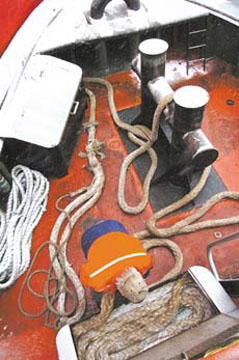
|
Here is a view of the bow of a tug that is
getting ready to dock a ship. The job can
be done from the stern and "made up" as well,
but we're going to talk about the most common
way that tugs move ships. The large
docking line is obvious. To the left,
coiled on deck is the messenger line. This
line is easily handled by the crew of the tug
and the ship and can be taken to a capstan and
hauled up under power without breaking like the
smaller heaving would. Sometimes the
docking line must be pulled dozens of feet up to
the ship and the weight of a wet line gets
heavier as it leaves the deck- much
heavier.
|
|
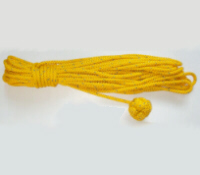 |
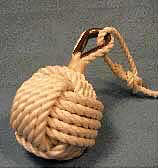 |
To get the
messenger up to the crew of the ship, the tug's
crew throws a heaving line. The heaving
line is fastened to the messenger and the ship's
crew can bring it up by hand no matter how high
or far away they are from the tug.
|
The
knot at the end of the heaving line is called a
Monkey's Fist Knot. The extra weight
on the end of the line makes the line sail
through the air for great distances. Many
boatmen pride themselves on the length and
accuracy of their throws.
|
Here is a
boatman making his throw. It looks
as though he must reach a height
directly over his head.
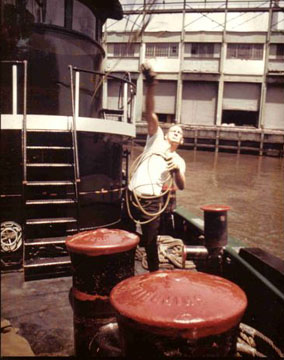
You can
see the messenger line on deck just
behind him.
|
|
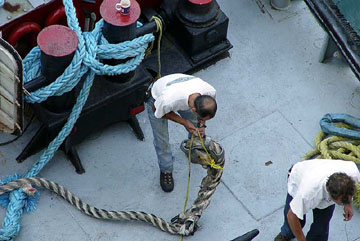
|
Here the tug's crew is fastening a messenger to
the end of another line to go up. There
are many configurations that the pilot may
request to move the ship depending on the
conditions. Sometimes more than one line
and different types of lines are employed.
|
|
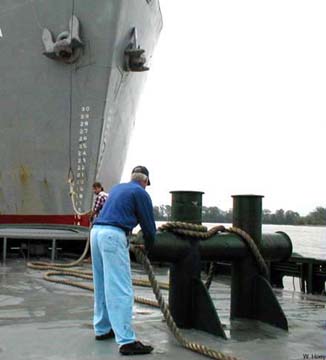
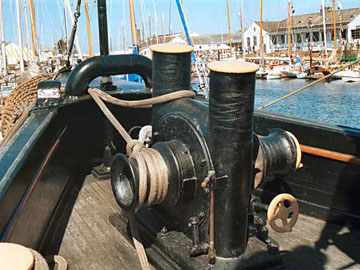 |
Here is the line going up. In the
foreground are the H-bitts that will be used to
fasten the docking line to the tug.
Whether on the stern or on the bow, the H-bitts
are the most important piece of deck furniture
on the tug, and the crew knows many ways to make
a line onto them.
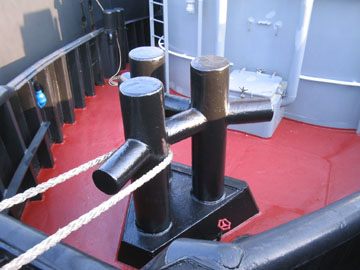
Here are different type of bitts. The set
above are in a triangular configuration and the
set to the left have a power capstan built onto
them to help bring long docking lines in tight.
No
matter what they look like, the important job
they do remains the same.
|
|
|
Once the line is up and both ends are fast, the
crew takes a short break while the captain and
the docking pilot do the rest.
Here is a tug positioned at the bow of the ship
it is moving. This is the most common job
of the ship docking tug in harbors.
|
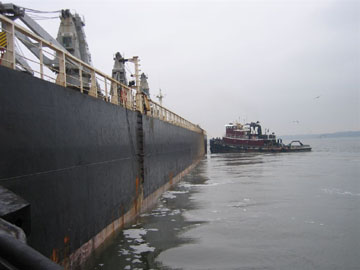
|
This is the docking pilot. He is in radio
contact with the tug's wheel house.
He
observes the movement of the ship from the
bridge wings and directs the ship's captain in
the use of his engines, while directing the
tug's captain to pull the ship with his line or
push against it with his fender system (also
known as pudding or puddening).
As
he gives a order to the tug, the tug can reply
with his whistle to acknowledge the order as
understood.
A
forward order gets one toot, and a backing order
gets two toots. Stopping orders get one
toot just a little longer than normal.
|
 |
|
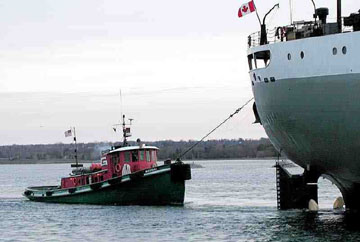
|
Here is a small tug with a line up on the
stern of a ship. Sometimes harbor tugs are
employed this way to help a ship steer while
transiting winding rivers. This is a job
that is going to the more modern ship docking
modules and tractor tugs, so popular these days.
There are many jobs that harbor do to move
ships, barges, and large marine equipment.
The job remains the same. Get to the job,
put up a line, and move around with power and
grace combined.
|
The
last whistle signal the crew hears is the long
toot followed by two short ones. "Bring
your line in." After the line is back
aboard the tug the crew can straighten up the
lines and decks and then get ready for the next
job, or the trip back to the yard for a break.
|